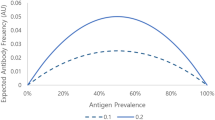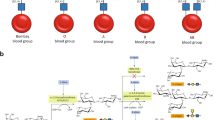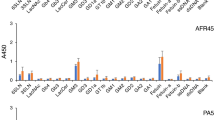Abstract
THE ‘D-like’ antigen has been demonstrated in all Rh positive and Rh negative human bloods including the rare D --/D -- and rGrG (ref. 1), as well as in rhesus and other lower monkey red blood cells, but it was not found in common laboratory animals2,3. One of the characteristics of this antigen is its capacity to induce formation of ‘anti-D-like’ anti-bodies in guinea pigs. These red cells which possess this antigen after exposure to its antibody yield eluates exhibiting the ‘D-like’ specificity.
This is a preview of subscription content, access via your institution
Access options
Subscribe to this journal
Receive 51 print issues and online access
$199.00 per year
only $3.90 per issue
Buy this article
- Purchase on Springer Link
- Instant access to full article PDF
Prices may be subject to local taxes which are calculated during checkout
Similar content being viewed by others
References
Levine, P., Rosenfield, R. E., and White, J., Amer. J. Human Genet., 13, 299 (1961).
Levine, P., Celano, M., Fenichel, R., and Singher, H., Science, 133, 332 (1961).
Levine, P., Celano, M., Fenichel, R., Pollack, W., and Singher, H., J. Immunol., 87, 747 (1961).
Vos, G. H., Vos, Dell., Kirk, R. L., and Sanger, R., Lancet, i, 14 (1961).
Murray, J., and Clark, E. C., Nature, 169, 886 (1952).
Author information
Authors and Affiliations
Rights and permissions
About this article
Cite this article
LEVINE, P., CELANO, M., VOS, G. et al. The First Human Blood, ---/---, which Lacks the ‘D-like’ Antigen. Nature 194, 304–305 (1962). https://doi.org/10.1038/194304a0
Issue Date:
DOI: https://doi.org/10.1038/194304a0
This article is cited by
-
Ungew�hnliche Rh-muster in einer Familie als Folge von St�rungen beim Aufbau der Antigene
Human Genetics (1970)
-
Problematische Rhesusausschl�sse
Deutsche Zeitschrift f�r die Gesamte Gerichtliche Medizin (1967)
-
A Second Example of – – –/– – – Blood or Rhnull
Nature (1964)
Comments
By submitting a comment you agree to abide by our Terms and Community Guidelines. If you find something abusive or that does not comply with our terms or guidelines please flag it as inappropriate.



